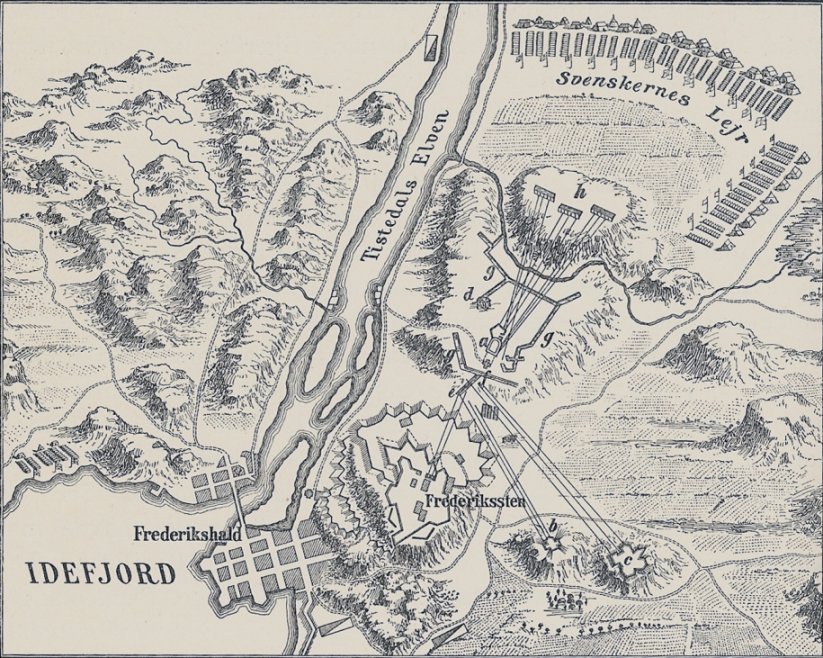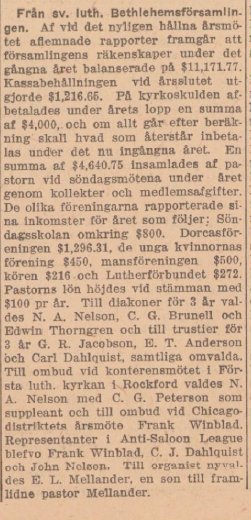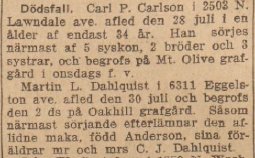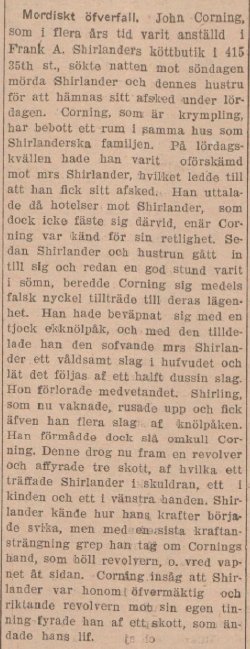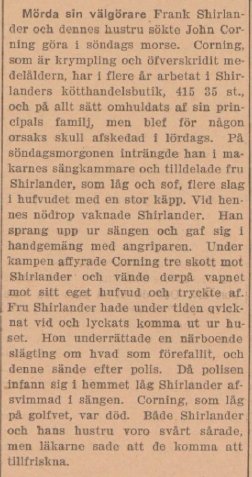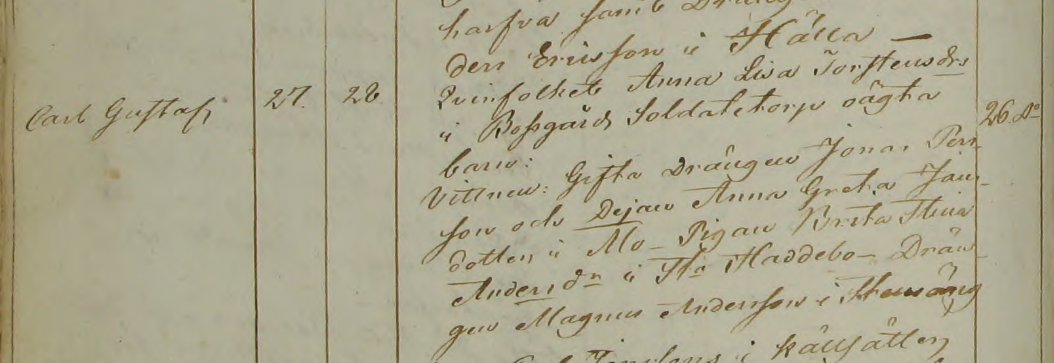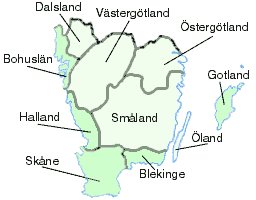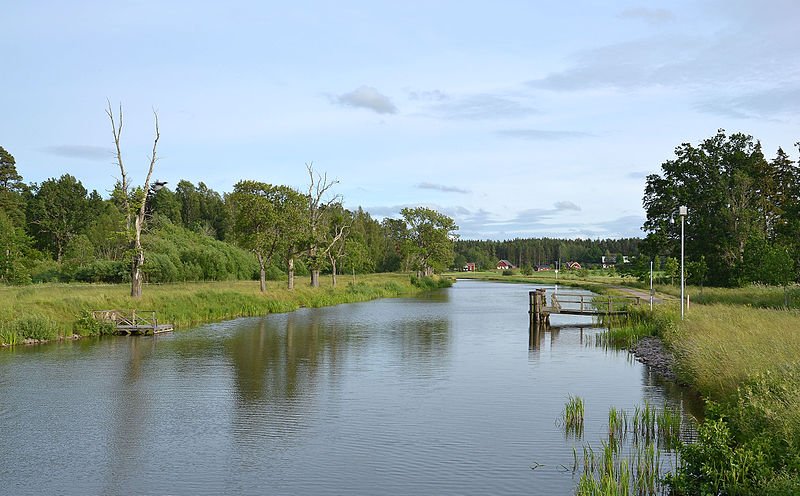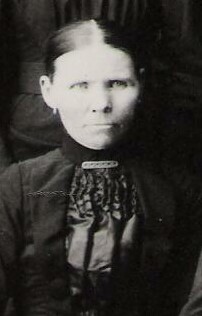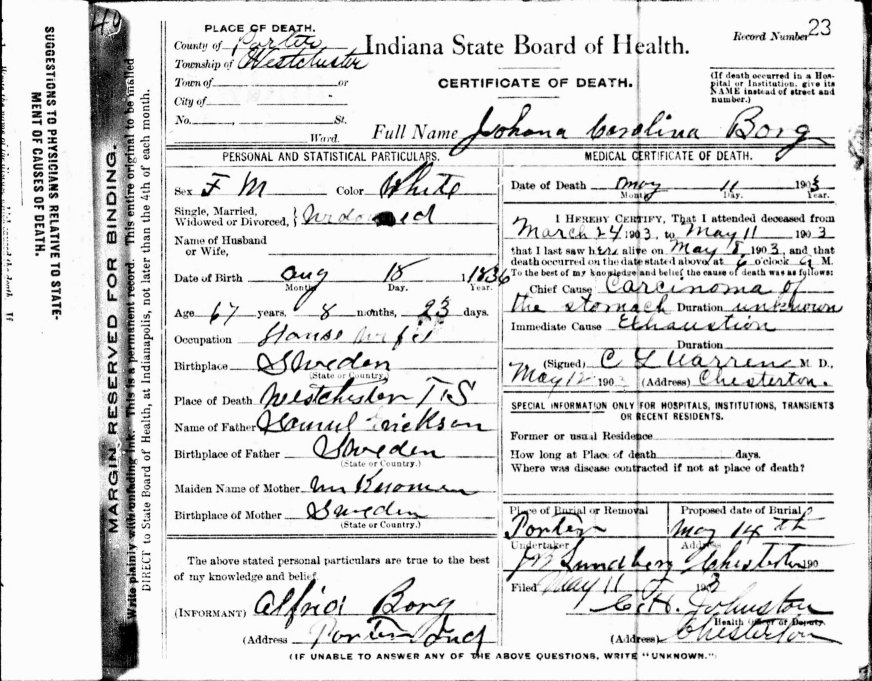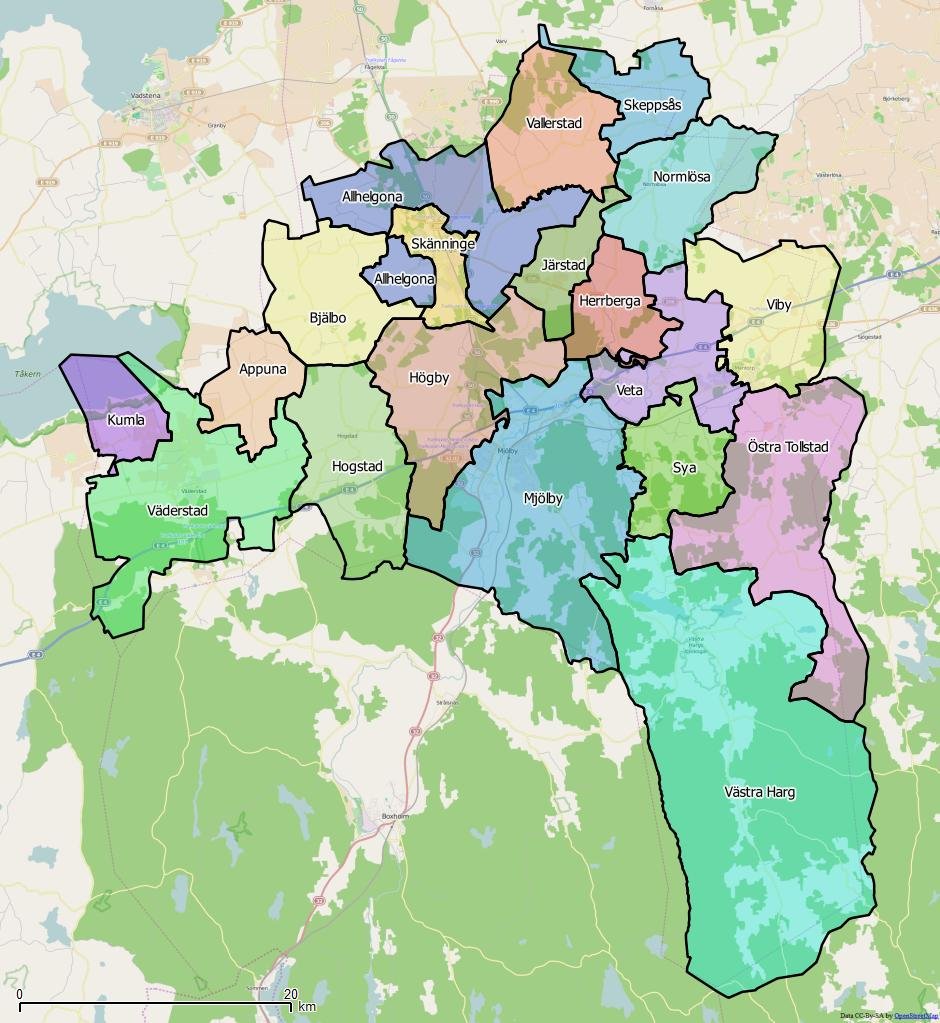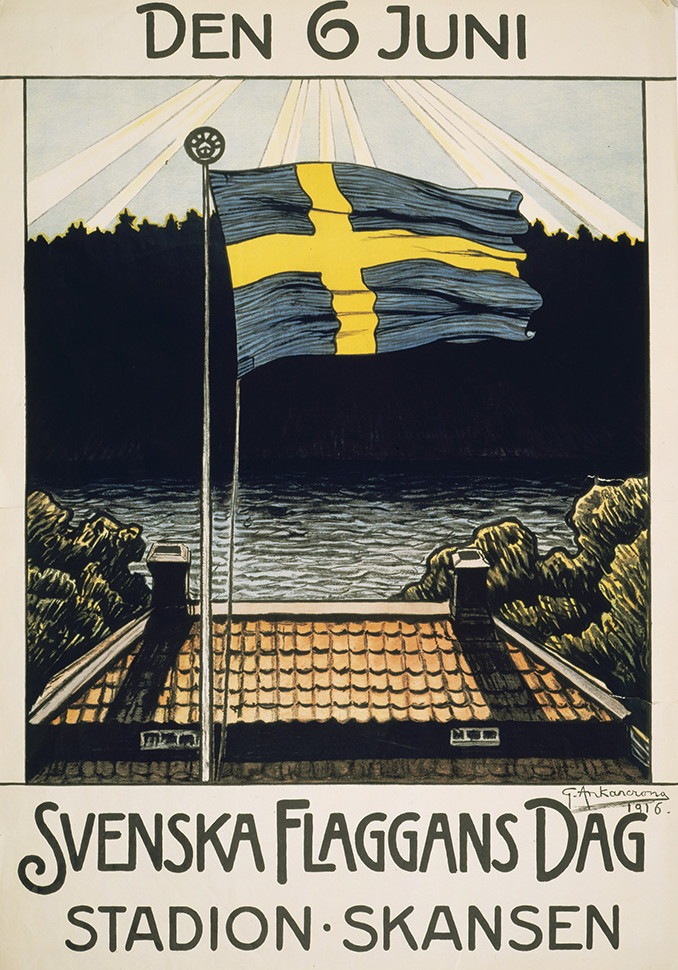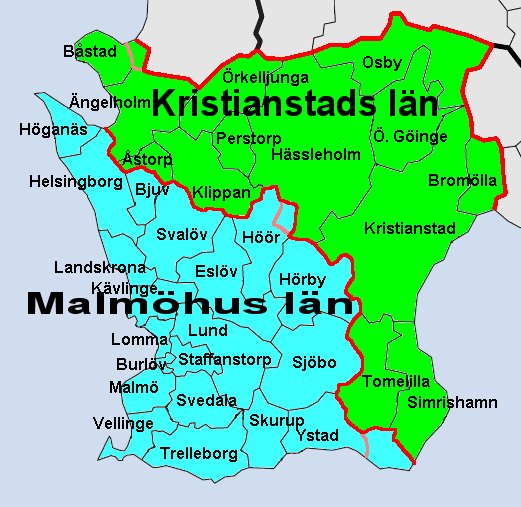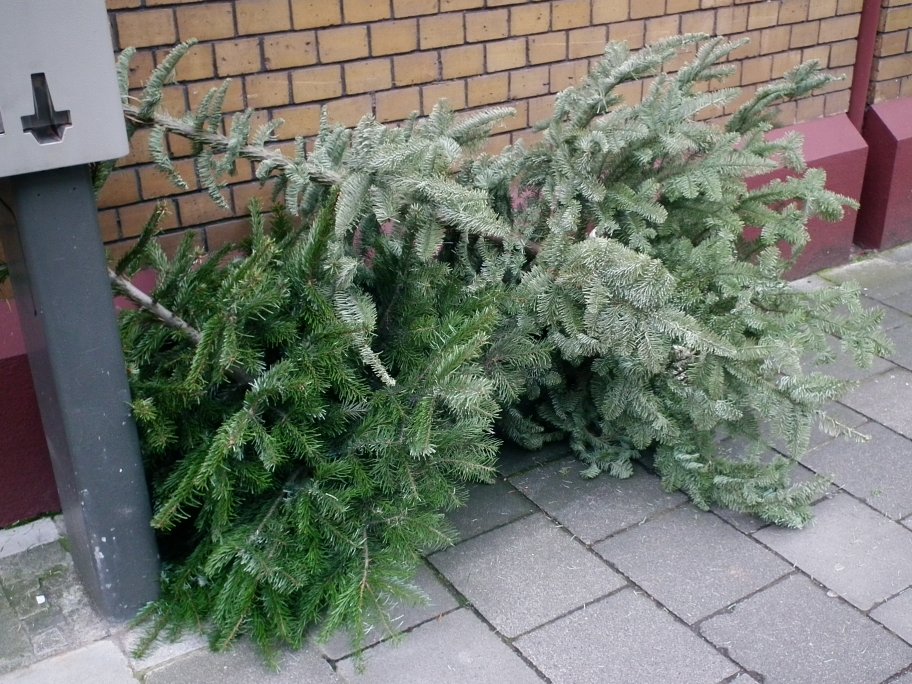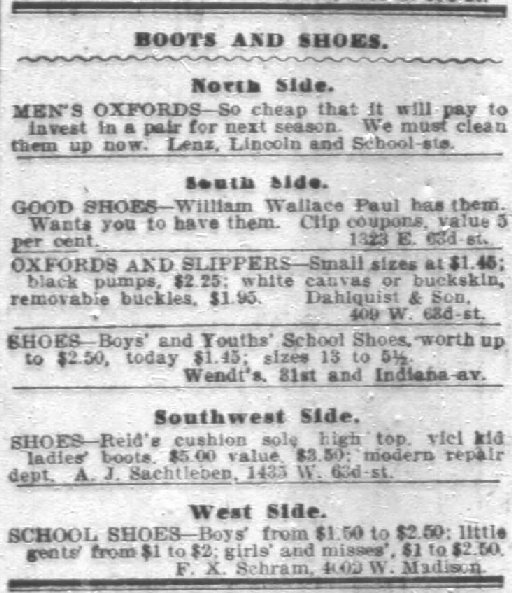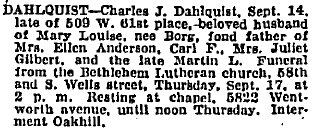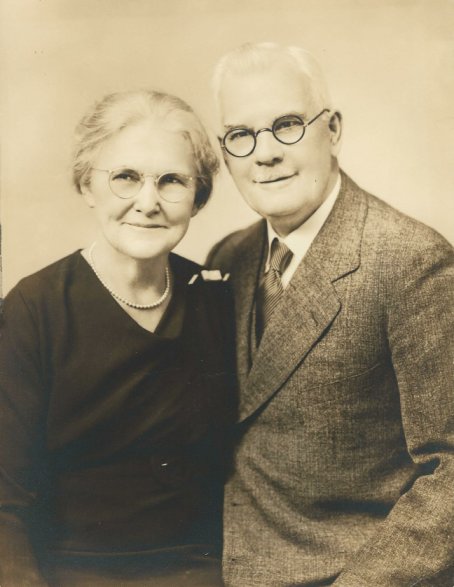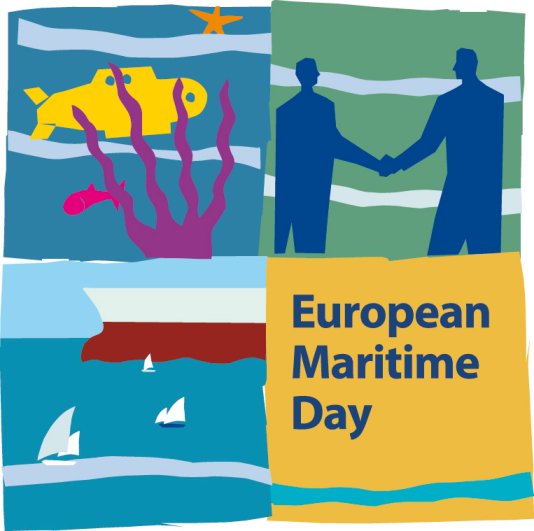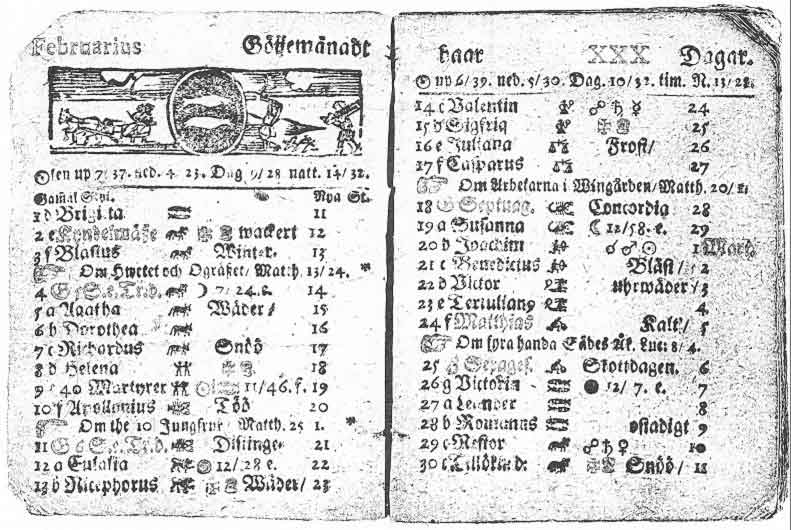Plan of the Siege of Frederiksten, 1718. Holm, Edvard. Danmarks Riges Historie, vol. 5, 1907. Public domain. Available from Wikimedia Commons.
On 30 November 1718, Charles XII of Sweden's troops attempted a siege on the Norwegian fortress of Fredriksten in the city of Fredrikshald (now Halden, Østfold). This was the last invasion of Norway during the Great Northern War. Charles XII was killed by a projectile while he was inspecting his troops' lines.
I am not sure if any of my ancestors participated in the Great Northern War, but I could have had ancestors on both sides, since I am both Swedish and Norwegian.
References
Siege of Fredriksten
Covering genealogy, family history, historical events and places, and anything else related!
Showing posts with label Sweden. Show all posts
Showing posts with label Sweden. Show all posts
Wednesday, November 30, 2016
Sunday, November 6, 2016
Finnish Swedish Heritage Day
Unofficial flag of Swedish-speaking Finns. By Mysid (Self-drawn in CorelDraw, based on FOTW.) [Public domain]. Available from Wikimedia Commons.
November 6 is Finnish Swedish Heritage Day. It is a celebration of Finland's Swedish-speaking population. The day was established in 1908 by the Swedish People's Party of Finland. November 6 was chosen because Gustavas Adolphus of Sweden was killed at the Battle of Lützen on 6 November 1632.
5.5 percent of the Finnish population speaks Swedish. Finland was part of Sweden for 700 years, and Swedish speakers have lived in Finland since the 1100s.
References
Finnish Swedish Heritage Day
How to be Finnish in Swedish - thisisFINLAND
November 6 is Finnish Swedish Heritage Day. It is a celebration of Finland's Swedish-speaking population. The day was established in 1908 by the Swedish People's Party of Finland. November 6 was chosen because Gustavas Adolphus of Sweden was killed at the Battle of Lützen on 6 November 1632.
5.5 percent of the Finnish population speaks Swedish. Finland was part of Sweden for 700 years, and Swedish speakers have lived in Finland since the 1100s.
References
Finnish Swedish Heritage Day
How to be Finnish in Swedish - thisisFINLAND
Tuesday, November 1, 2016
Tuesday's Tip: Swedish-American Newspapers
The Minnesota Historical Society provides access to 28 Swedish-American newspapers published between 1859 and 2007. These newspapers were published for the Swedish immigrant communities. More than 300,000 digitized pages are available for searching and browsing. There is a text correction tool that you can use to correct mistakes. There is also a user annotation tool, which can be used to add comments and tags.
I found some interesting things in this collection. My ancestors attended the Bethlehem Lutheran Church in Chicago, and news from the church was published. My great-grandfather Edward Theodore Anderson and his brother-in-law Carl Dahlquist were elected to serve as deacons. My 2nd-great-grandfather C. J. Dahlquist (Carl's father) was in the Anti-Saloon League (something that I was previously unaware of).
I found a death notice for C. J. Dahlquist's son Martin L. Dahlquist.
C. J. Dahlquist's brother Frank A. Shirlander and his wife were attacked by a former employee in 1905. The incident was reported in two Swedish-American newspapers.
If you have Swedish ancestors who immigrated to the United States, this collection is worth a look. The collection can be accessed at http://www.mnhs.org/newspapers/swedishamerican.
I found some interesting things in this collection. My ancestors attended the Bethlehem Lutheran Church in Chicago, and news from the church was published. My great-grandfather Edward Theodore Anderson and his brother-in-law Carl Dahlquist were elected to serve as deacons. My 2nd-great-grandfather C. J. Dahlquist (Carl's father) was in the Anti-Saloon League (something that I was previously unaware of).
Svenska Amerikanaren, 18 January 1917, page 15
I found a death notice for C. J. Dahlquist's son Martin L. Dahlquist.
Svenska Tribunen-Nyheter, 6 August 1919, page 12
C. J. Dahlquist's brother Frank A. Shirlander and his wife were attacked by a former employee in 1905. The incident was reported in two Swedish-American newspapers.
Svenska Amerikanaren, 30 May 1905, page 11
Svenska Tribunen, 31 May 1905, page 11
If you have Swedish ancestors who immigrated to the United States, this collection is worth a look. The collection can be accessed at http://www.mnhs.org/newspapers/swedishamerican.
Labels:
Anderson,
Chicago,
Dahlquist,
Illinois,
Minnesota,
Shirlander,
Sweden,
Tuesday's Tip
Saturday, October 15, 2016
Sibling Saturday: Finding a Previously Unknown Half-Brother
When I obtained the Civil War pension application of Samuel August Samuelson, the brother of my 3rd-great-grandmother Johanna Carolina Samuelson, I discovered a previously unknown family member.
Statement of C. J. Johnson. Samuel A. Samuelson (Pvt., Co. E, 73rd Ind. Inf., Civil War, pension application no. 283,424, certificate no. 217,996),Case Files of Approved Pension Applications..., 1861-1934; Civil War and Later Pension Files; Department of Veterans Affairs, Record Group 15; National Archives, Washington, D.C.
C. G. Johnson gave a statement, and was asked if he was in any was related to Samuel A. Samuelson. He answered, "I am what is called a half brother."
I knew that Johanna and Samuel had two older brothers, Johan Peter and Anders Fredrik, but I did not know that they had a half-brother. Their mother, Anna Lisa Torstensdotter, was thirteen years older than their father, Samuel Eriksson, so I wondered if C. G. Johnson was her son from a previous marriage.
I found Carl Gustaf Johnson's death certificate in Ancestry.com's database Indiana, Death Certificates, 1899-2011. He had died in Westchester, Porter County, Indiana on 30 July 1909. The death certificate gave his date of birth: 27 October 1823. His birthplace was listed as Vastra Harg, Sweden.
Indiana State Board of Health. Death certificate no. 109, Carl Gustaf Johnson, 1909. Ancestry.com. Indiana, Death Certificates, 1899-2011 [database on-line]. Provo, UT, USA: Ancestry.com Operations, Inc., 2015.
I had already known that the family had come from Västra Harg, Östergötland, Sweden. I looked at the Swedish records on ArkivDigital, and found Carl Gustaf's birth and baptismal record. He was not a child from a previous marriage; he was an illegitimate child. The record did not name his father.
I found the family in the household examination records, after Anna Lisa Torstensdotter had married Samuel Eriksson. Carl Gustaf was listed with the patronymic Jaensson.
Carl Gustaf Johnson married Matilda Sofia Johnson. According to the 1900 United States Census, Matilda had six children.
1900 United States census, Westchester, Porter County, Indiana, population schedule, enumeration district 94, page 3B. Ancestry.com. 1900 United States Federal Census [database on-line]. Provo, UT, USA: Ancestry.com Operations Inc, 2004.
However, I have only discovered four of the children: Albertena Johnson (born 15 August 1868), Albert L. Johnson (born about 1874), Ida Johnson (born 24 March 1875 or 1876), and Gustaf Johnson (born 29 March 1883).
Statement of C. J. Johnson. Samuel A. Samuelson (Pvt., Co. E, 73rd Ind. Inf., Civil War, pension application no. 283,424, certificate no. 217,996),Case Files of Approved Pension Applications..., 1861-1934; Civil War and Later Pension Files; Department of Veterans Affairs, Record Group 15; National Archives, Washington, D.C.
C. G. Johnson gave a statement, and was asked if he was in any was related to Samuel A. Samuelson. He answered, "I am what is called a half brother."
I knew that Johanna and Samuel had two older brothers, Johan Peter and Anders Fredrik, but I did not know that they had a half-brother. Their mother, Anna Lisa Torstensdotter, was thirteen years older than their father, Samuel Eriksson, so I wondered if C. G. Johnson was her son from a previous marriage.
I found Carl Gustaf Johnson's death certificate in Ancestry.com's database Indiana, Death Certificates, 1899-2011. He had died in Westchester, Porter County, Indiana on 30 July 1909. The death certificate gave his date of birth: 27 October 1823. His birthplace was listed as Vastra Harg, Sweden.
Indiana State Board of Health. Death certificate no. 109, Carl Gustaf Johnson, 1909. Ancestry.com. Indiana, Death Certificates, 1899-2011 [database on-line]. Provo, UT, USA: Ancestry.com Operations, Inc., 2015.
I had already known that the family had come from Västra Harg, Östergötland, Sweden. I looked at the Swedish records on ArkivDigital, and found Carl Gustaf's birth and baptismal record. He was not a child from a previous marriage; he was an illegitimate child. The record did not name his father.
Västra Harg C:1 (1797-1840) Image 179 / page 341 (AID: v42201.b179.s341, NAD: SE/VALA/00446)
I found the family in the household examination records, after Anna Lisa Torstensdotter had married Samuel Eriksson. Carl Gustaf was listed with the patronymic Jaensson.
Västra Harg AI:11 (1835-1840) Image 88 / page 159 (AID: v27140.b88.s159, NAD: SE/VALA/00446)
Carl Gustaf Johnson married Matilda Sofia Johnson. According to the 1900 United States Census, Matilda had six children.
1900 United States census, Westchester, Porter County, Indiana, population schedule, enumeration district 94, page 3B. Ancestry.com. 1900 United States Federal Census [database on-line]. Provo, UT, USA: Ancestry.com Operations Inc, 2004.
However, I have only discovered four of the children: Albertena Johnson (born 15 August 1868), Albert L. Johnson (born about 1874), Ida Johnson (born 24 March 1875 or 1876), and Gustaf Johnson (born 29 March 1883).
Monday, September 12, 2016
Mappy Monday: Provinces of Götaland, Sweden
Map of Götaland, showing the smaller regions (landskap). CC BY-SA 3.0 (http://creativecommons.org/licenses/by-sa/3.0). Available from Wikimedia Commons.
This map shows the provinces that make up Götaland, one of the three lands of Sweden. All of my known Swedish ancestors came from Götaland.
This map shows the provinces that make up Götaland, one of the three lands of Sweden. All of my known Swedish ancestors came from Götaland.
Tuesday, August 23, 2016
Travel Tuesday: A. T. Anderson's Visit to Sweden
In 1912, my 2nd-great-grandfather Andrew T. Anderson (born Andreas Troedsson) traveled to Sweden to visit his family. He arrived in Sweden in late May 1912. He stayed with his sister Carolina and her husband Nils Andersson on Ollof farm in Grevie, Skåne. He wrote a letter to his wife and children on 7 June 1912. He said that they had had Sunday School there the previous Sunday, and that he was not able to attend church because he only had his old clothes. His trunk of clothing did not arrive until the day before he wrote the letter. Later that Sunday, he, Carolina, and Carolina's son Elof and his family drove to visit Pat Johnson. He planned to buy dress material for his wife the next day.
He was asked to lead Sunday school in the American fashion on the following Sunday. He also planned to visit his brother Johannes that day.
Carolina made a cheese for him to take home to his family, and made another one for him to bring home to to their sister Johanna.
Andrew/Andreas said that he and his brother-in-law Nils went to the forest one evening and heard a nightingale singing in the treetops at 11:00.
Common Nightingale Luscinia megarhynchos, near Gordevio, Ticino, Switzerland. 12 May 2010. Photo by Noel Reynolds [CC BY 2.0 (http://creativecommons.org/licenses/by/2.0)]. Available from Flickr and Wikimedia Commons.
He thought that he might go to Helsingborg and Copenhagen the following week. On 28 June 1912, he planned travel on the Göta Canal and go to Stockholm and see museums and art.
Göta kanal (Göta canal) near road E20, Sweden. 7 July 2015. Photo by Pudelek (Own work) [CC BY-SA 4.0 (http://creativecommons.org/licenses/by-sa/4.0)]. Available from Wikimedia Commons.
On 20 July 1912, he sailed from Liverpool, England to New York, New York on the Caronia.
RMS Caronia. Cunard Line, 1905-1933. Ancestry.com. Passenger Ships and Images [database on-line]. Provo, UT, USA: Ancestry.com Operations Inc, 2007.
He arrived at Ellis Island on 28 July 1912.
Passenger manifest, Caronia. 28 July 1912. Microfilm serial T715, 1897-195, microfilm roll 1904, line 6, page number 24. Ancestry.com. New York, Passenger Lists, 1820-1957 [database on-line]. Provo, UT, USA: Ancestry.com Operations, Inc., 2010. Passenger Lists of Vessels Arriving at New York, New York, 1820-1897. Microfilm Publication M237, 675 rolls. NAI: 6256867. Records of the U.S. Customs Service, Record Group 36. National Archives at Washington, D.C.
Passenger manifest, Caronia. 28 July 1912. Microfilm serial T715, 1897-195, microfilm roll 1904, line 6, page number 24. Ancestry.com. New York, Passenger Lists, 1820-1957 [database on-line]. Provo, UT, USA: Ancestry.com Operations, Inc., 2010. Passenger Lists of Vessels Arriving at New York, New York, 1820-1897. Microfilm Publication M237, 675 rolls. NAI: 6256867. Records of the U.S. Customs Service, Record Group 36. National Archives at Washington, D.C.
This was probably the last time that he saw his family in Sweden. He died on 24 January 1916.
He was asked to lead Sunday school in the American fashion on the following Sunday. He also planned to visit his brother Johannes that day.
Carolina made a cheese for him to take home to his family, and made another one for him to bring home to to their sister Johanna.
Andrew/Andreas said that he and his brother-in-law Nils went to the forest one evening and heard a nightingale singing in the treetops at 11:00.
Common Nightingale Luscinia megarhynchos, near Gordevio, Ticino, Switzerland. 12 May 2010. Photo by Noel Reynolds [CC BY 2.0 (http://creativecommons.org/licenses/by/2.0)]. Available from Flickr and Wikimedia Commons.
He thought that he might go to Helsingborg and Copenhagen the following week. On 28 June 1912, he planned travel on the Göta Canal and go to Stockholm and see museums and art.
Göta kanal (Göta canal) near road E20, Sweden. 7 July 2015. Photo by Pudelek (Own work) [CC BY-SA 4.0 (http://creativecommons.org/licenses/by-sa/4.0)]. Available from Wikimedia Commons.
On 20 July 1912, he sailed from Liverpool, England to New York, New York on the Caronia.
RMS Caronia. Cunard Line, 1905-1933. Ancestry.com. Passenger Ships and Images [database on-line]. Provo, UT, USA: Ancestry.com Operations Inc, 2007.
He arrived at Ellis Island on 28 July 1912.
Passenger manifest, Caronia. 28 July 1912. Microfilm serial T715, 1897-195, microfilm roll 1904, line 6, page number 24. Ancestry.com. New York, Passenger Lists, 1820-1957 [database on-line]. Provo, UT, USA: Ancestry.com Operations, Inc., 2010. Passenger Lists of Vessels Arriving at New York, New York, 1820-1897. Microfilm Publication M237, 675 rolls. NAI: 6256867. Records of the U.S. Customs Service, Record Group 36. National Archives at Washington, D.C.
Passenger manifest, Caronia. 28 July 1912. Microfilm serial T715, 1897-195, microfilm roll 1904, line 6, page number 24. Ancestry.com. New York, Passenger Lists, 1820-1957 [database on-line]. Provo, UT, USA: Ancestry.com Operations, Inc., 2010. Passenger Lists of Vessels Arriving at New York, New York, 1820-1897. Microfilm Publication M237, 675 rolls. NAI: 6256867. Records of the U.S. Customs Service, Record Group 36. National Archives at Washington, D.C.
This was probably the last time that he saw his family in Sweden. He died on 24 January 1916.
Thursday, August 18, 2016
Johanna Carolina Samuelsdotter
Johanna Carolina
My 3rd-great-grandmother Johanna Carolina Samuelsdotter (Samuelson, Erickson) was born 180 years ago today, on 18 August 1836, in Västra Harg, Östergötland, Sweden. She was the daughter of Samuel Eriksson/Erickson and Anna Lisa Torstensdotter.Johanna was baptized on 21 August 1836.
Västra Harg C:1 (1797-1840) Image 250 / page 483 (AID: v42201.b250.s483, NAD: SE/VALA/00446).
In 1851, Johanna, her parents, and her brothers Anders and Samuel left Sweden. Johanna's oldest brother Johan Peter did not go with them.
The family arrived in New York, New York on the Preciosa on 8 September 1851.
Passenger list, Preciosa, 1851. Ancestry.com. New York, Passenger Lists, 1820-1957 [database on-line]. Provo, UT, USA: Ancestry.com Operations, Inc., 2010.
The family spent a year in Chicago, and then settled in Westchester, Porter County, Indiana. Johanna married Johannes "John" Borg, and their first child, Clara Matilda, was born on 29 August 1858. Their second child, Anna Christina, was born on 24 August 1860.
1860 United States census, Westchester, Porter County, Indiana, population schedule, page 466, family 281. Ancestry.com. 1860 United States Federal Census [database on-line]. Provo, UT, USA: Ancestry.com Operations, Inc., 2009.
By 1860, Johanna's brother Johan Peter had joined the family in Porter County, Indiana.
John and Johanna's third child, my 2nd-great-grandmother Mary/Marie Louise Borg, was born on 13 January 1864. Their first son, Alfred, was born almost exactly two years later, on 15 January 1866. Another son, Carl Gust, was born a little over two years later, on 26 January 1868.
Johanna's mother Anna Lisa had died by 1870. Johanna had four more children during the 1870s: Emil Richard (born 11 June 1870), Minnie (born September 1872), Malinda (born 16 March 1875), and Carl/Charles John (born 28 July 1878).
1880 United States census, Westchester, Porter County, Indiana, population schedule, enumeration district 136, p. 399A, family 243. Ancestry.com and The Church of Jesus Christ of Latter-day Saints. 1880 United States Federal Census [database on-line]. Provo, UT, USA: Ancestry.com Operations Inc, 2010.
Johanna had two more children during the 1880s: David Theodore (born 21 October 1880) and Daniel Elvin (born 17 October 1882).
In September 1888, the family moved into a new house, which was designed by A. J. Lundquist.
Johanna experienced two losses in less than two years. Her son Carl/Charles John died of typhus fever on 18 October 1889. Her father Samuel Erickson died of dropsy on 18 July 1890. Six years later, Johanna became a widow; her husband John died of cancer on 20 September 1896.
In 1900, Johanna lived with her daughter Clara and her sons David and Daniel. Three months after the census was taken, Clara married Nels A. Samuelson, whose family was listed underneath the Borg family in the 1900 census.
1900 United States census, Westchester, Porter County, Indiana, population schedule, enumeration district 95, p. 8B, families 168 and 169. Ancestry.com. 1900 United States Federal Census [database on-line]. Provo, UT, USA: Ancestry.com Operations Inc, 2004.
Johanna died on 11 May 1903 in Westchester, Porter County, Indiana. The cause of death was carcinoma of the stomach. She was buried in Augsburg Lutheran Church Cemetery in Porter, Porter County, Indiana.
Indiana State Board of Health. Death certificate no. 23, Johana Carolina Borg, 1903. Ancestry.com. Indiana, Death Certificates, 1899-2011 [database on-line]. Provo, UT, USA: Ancestry.com Operations, Inc., 2015.
Labels:
Borg,
Erickson,
Indiana,
Östergötland,
Samuelson,
Sweden,
Västra Harg
Wednesday, June 15, 2016
Monday, June 13, 2016
Mappy Monday: Districts in Mjölby Municipality, Sweden
District subdivisions in Mjölby Municipality. Lantmäteriet [ODbL (http://opendatacommons.org/licenses/odbl/1.0/), CC BY-SA 2.5 (http://creativecommons.org/licenses/by-sa/2.5) or CC BY-SA 2.5 (http://creativecommons.org/licenses/by-sa/2.5)]. Available from Wikimedia Commons.
This map shows the districts in Mjölby Municipality, Östergötland, Sweden. My Borg ancestors were from what is now Mjölby Municipality (Östra Tollstad and Västra Harg).
This map shows the districts in Mjölby Municipality, Östergötland, Sweden. My Borg ancestors were from what is now Mjölby Municipality (Östra Tollstad and Västra Harg).
Monday, June 6, 2016
National Day of Sweden
Poster. Swedish Flag Day in 1916. By Gustaf Ankarcrona [Public domain]. Nordic Museum's photographic studio, Nordic Museum. Available from Nordiska Museet and Wikimedia Commons.
June 6 is the National Day of Sweden. It was first celebrated in 1916, and was formerly known as Swedish Flag Day. The above poster is from 1916. The translation of the poster's text is "On June 6, the Swedish Flag Day, Stadium Skansen, Hasselbacken."
June 6 is the National Day of Sweden. It was first celebrated in 1916, and was formerly known as Swedish Flag Day. The above poster is from 1916. The translation of the poster's text is "On June 6, the Swedish Flag Day, Stadium Skansen, Hasselbacken."
Monday, May 23, 2016
Mappy Monday: Skåne Län Before 1997
Old provinces of Skåne. By Lunnen2009 (Own work) [GFDL (http://www.gnu.org/copyleft/fdl.html) or CC BY-SA 3.0 (http://creativecommons.org/licenses/by-sa/3.0)]. Available from Wikimedia Commons.
Skåne län [county], the southernmost county in Sweden, was created in 1997. Two counties, Kristianstad and Malmöhus, were merged.
My 2nd-great-grandfather Andreas Troedsson/Andrew T. Anderson and his ancestors were from Grevie, which is part of the municipality of Båstad. It was located in Kristianstads län and is now in Skåne län.
Skåne län [county], the southernmost county in Sweden, was created in 1997. Two counties, Kristianstad and Malmöhus, were merged.
My 2nd-great-grandfather Andreas Troedsson/Andrew T. Anderson and his ancestors were from Grevie, which is part of the municipality of Båstad. It was located in Kristianstads län and is now in Skåne län.
Monday, April 11, 2016
Mappy Monday: Swedish Empire (1560-1815)
Swedish Empire in Early Modern Europe (1560-1815). Derivative work by M.K, based on Swedish Empire (1560-1815) blank.svg by Justass, based on Ortus-imperii-suecorum.png by Memnon335bc [CC BY 3.0 (http://creativecommons.org/licenses/by/3.0) or GFDL (http://www.gnu.org/copyleft/fdl.html)]. Available from Wikimedia Commons.
This map shows the Swedish Empire from 1560 to 1815. The years of acquisitions and losses are included. Finland was part of the Swedish Empire for most of this period.
This map shows the Swedish Empire from 1560 to 1815. The years of acquisitions and losses are included. Finland was part of the Swedish Empire for most of this period.
Monday, March 21, 2016
World Down Syndrome Day
March 21 is World Down Syndrome Day. Since 2005, events have been held on this day to raise awareness of Down Syndrome and to show how people with Down Syndrome can play active roles in their communities.
My 2nd-great-grandfather's brother Petter Troedsson was listed as idiot krympling [idiot cripple] in Swedish household examination records. Their mother Christina Jacobsdotter was 38 years old when Petter was born on 31 January 1855 in Grevie, Skåne, Sweden. I suspect that Petter may have had Down Syndrome.
Petter died on 27 October 1908 in Grevie, Skåne, Sweden. He was 53 years old and a pauper in the Grevie workhouse. The cause of death was dropsy.
Peter Troedsson death record, 27 October 1908. Grevie FI:3 (1895-1943) Image 580 / page 53 (AID: v516961.b580.s53, NAD: SE/LLA/13113).
My 2nd-great-grandfather's brother Petter Troedsson was listed as idiot krympling [idiot cripple] in Swedish household examination records. Their mother Christina Jacobsdotter was 38 years old when Petter was born on 31 January 1855 in Grevie, Skåne, Sweden. I suspect that Petter may have had Down Syndrome.
Grevie AI:14 (1870-1876) Image 80 / page 4 (AID: v99265a.b80.s4, NAD: SE/LLA/13113).
Petter died on 27 October 1908 in Grevie, Skåne, Sweden. He was 53 years old and a pauper in the Grevie workhouse. The cause of death was dropsy.
Peter Troedsson death record, 27 October 1908. Grevie FI:3 (1895-1943) Image 580 / page 53 (AID: v516961.b580.s53, NAD: SE/LLA/13113).
Tuesday, February 9, 2016
Fettisdagen
Semla or fastlagsbulle (Swedish), laskiaispulla (Finnish) or fastelavnsbolle (Danish and Norwegian), traditional roll, associated with Lent and especially Shrove Monday or Shrove Tuesday. 22 February 2012. Photo by poo [CC BY-SA 3.0 (http://creativecommons.org/licenses/by-sa/3.0)]. Available from Wikimedia Commons.
Fettisdagen (Fat Tuesday) is the Swedish name for Shrove Tuesday, the last day before the beginning of the Lenten fast. Buns called semla, fastlagsbullar, or fettisdagsbullar are traditionally eaten on this day. Since Swedes no longer observe a strict Lenten fast, semlor (plural of semla) are eaten every Tuesday between Fettisdagen and Easter. They are available in stores and bakeries shortly after Christmas. Swedish bakers sell 2 million semlor on Fettisdagen. The coffee shop Vette-Katten sells 14,000 semlor on Fettisdagen.
Semlor are cardamom spiced wheat buns which have had the tops cut off and the insides scooped out, and then are filled with almond paste and topped with whipped cream and sugar. They may be eaten with coffee or tea, or submerged in bowls of warm milk.
References
Fettisdagen
Get to know the famous Semla!
Semla
The semla – more than just a bun
Shrove Tuesday (Fettisdagen)
Fettisdagen (Fat Tuesday) is the Swedish name for Shrove Tuesday, the last day before the beginning of the Lenten fast. Buns called semla, fastlagsbullar, or fettisdagsbullar are traditionally eaten on this day. Since Swedes no longer observe a strict Lenten fast, semlor (plural of semla) are eaten every Tuesday between Fettisdagen and Easter. They are available in stores and bakeries shortly after Christmas. Swedish bakers sell 2 million semlor on Fettisdagen. The coffee shop Vette-Katten sells 14,000 semlor on Fettisdagen.
Semlor are cardamom spiced wheat buns which have had the tops cut off and the insides scooped out, and then are filled with almond paste and topped with whipped cream and sugar. They may be eaten with coffee or tea, or submerged in bowls of warm milk.
References
Fettisdagen
Get to know the famous Semla!
Semla
The semla – more than just a bun
Shrove Tuesday (Fettisdagen)
Wednesday, January 13, 2016
Twentieth Day After Christmas/St. Knut's Day
Discarded Christmas trees. 20 January 2011. Photo by 4028mdk09 (Own work) [CC BY-SA 3.0 (http://creativecommons.org/licenses/by-sa/3.0)]. Available from Wikimedia Commons.
Twenty days after Christmas, celebrations take place in Norway, Sweden, and Finland. In Norway, January 13 is Tyvendedagen (Twentieth Day, or Little Christmas Day). In Sweden, January 13 is Tjugondedag Jul (Twentieth Day Yule) or Tjugondedag Knut (St. Knut's Day). In Finland, January 23 is known as Nuutinpäivä. (St. Knut's Day).
On this day, Christmas trees are taken down, and any leftover food (such as candies and cookies used to decorate the tree) is eaten. In Sweden, families call this Julgransplundring ("plunder the Christmas tree.")
In Norway, there is a folk saying that "Saint Knut drives Christmas away." Christmas races have traditionally been held in some areas.
In Finland, young men traditionally dressed as a goat (Nuuttipukki) and visited houses. The goat was supposed to be scary.
References
8 Festivals of Norway
Little Christmas
St. Knut's Day
Trettondedag Jul, Tjugondedag Knut?
Twenty days after Christmas, celebrations take place in Norway, Sweden, and Finland. In Norway, January 13 is Tyvendedagen (Twentieth Day, or Little Christmas Day). In Sweden, January 13 is Tjugondedag Jul (Twentieth Day Yule) or Tjugondedag Knut (St. Knut's Day). In Finland, January 23 is known as Nuutinpäivä. (St. Knut's Day).
On this day, Christmas trees are taken down, and any leftover food (such as candies and cookies used to decorate the tree) is eaten. In Sweden, families call this Julgransplundring ("plunder the Christmas tree.")
In Norway, there is a folk saying that "Saint Knut drives Christmas away." Christmas races have traditionally been held in some areas.
In Finland, young men traditionally dressed as a goat (Nuuttipukki) and visited houses. The goat was supposed to be scary.
References
8 Festivals of Norway
Little Christmas
St. Knut's Day
Trettondedag Jul, Tjugondedag Knut?
Wednesday, November 18, 2015
52 Ancestors: Week 46 "Changes": C. J. Dahlquist
My 2nd-great-grandfather Carl Johan/Charles John Dahlquist went through many changes during his lifetime, including his name, his country of residence, his citizenship, and his business partners.
Carl Johan was born on 13 June 1862 in Kinneved, Skaraborg, Västergötland, Sweden, and was baptized on 15 June 1862. He was the son of Johannes Christiansson and Maria Christina Jonsdotter.
Birth/baptism record for Carl Johan, 1862. Kinneved C:3 (1851-1885) Image 45 (AID: v55921.b45, NAD: SE/GLA/13283), image 45.
On 23 September 1881, he left Gothenburg, Sweden on the Orlando. By this time, he was using the name C. J. Dahlqvist.
C. J. Dahlqvist. Orlando passenger list. Gothenburg, Sweden. 23 September 1881. Ancestry.com. Gothenburg, Sweden, Passenger Lists, 1869-1951 [database on-line]. Provo, UT, USA: Ancestry.com Operations, Inc., 2010. Original data: Göteborgs Poliskammare, EIX 1-143, 1869–1950. Landsarkivet i Göteborg, Göteborg, Sweden.
On the Orlando, he sailed to Hull, England. The articles Migration from Northern Europe to America via the Port of Hull, 1848-1914 and Conditions for Emigrants on the Voyage from Gothenburg to Hull provide insight regarding his experience. According to the Orlando passenger list, his final destination was New York, but he settled in Chicago, Illinois. In the United States, he was known as Charles John Dahlquist.
In 1882, his younger brother Frans August Johanson left Sweden for Chicago. By 1889, he had changed his name to Frank A. Shirlander. The oldest brother, Alfrid, remained in Sweden. He took his father's patronymic as his surname and was known as Alfrid Kristiansson. Three brothers, three different surnames!
On 20 December 1885, he married Marie (or Mary) Louise Borg at the Swedish Lutheran Church in Baillytown, Porter County, Indiana.
Indiana Marriages, 1811-2007," database with images, FamilySearch (https://familysearch.org/ark:/61903/1:1:KDHQ-35C), Charles J. Dahlquist and Mary Clara Borg, 20 Dec 1885; citing Valparaiso, Porter, Indiana, county clerk offices, Indiana; FHL microfilm 1,686,157. Mary's middle name is incorrect on the document. Note that when Rev. A. Challman filled out the form, he gave her name as Mary L. Borg.
Charles and Marie lived in Chicago after their marriage.Their first child, my great-grandmother Ellen Victoria Dahlquist, was born on 8 September 1886. Their second child and first son, Carl Frederick Dahlquist, was born on 10 January 1888.
Charles was naturalized on 28 August 1888.
Charles J. J. Dahlquist naturalization, 28 August 1888. Superior Court, Cook County, Illinois. National Archives and Records Administration (NARA); Washington, D.C.; Soundex Index to Naturalization Petitions for the United States District and Circuit Courts, Northern District of Illinois and Immigration and Naturalization Service District 9, 1840-1950 (M1285); Microfilm Serial: M1285; Microfilm Roll: 44. Ancestry.com. U.S. Naturalization Record Indexes, 1791-1992 (Indexed in World Archives Project) [database on-line]. Provo, UT, USA: Ancestry.com Operations, Inc., 2010.
Charles and Marie had two more children: Martin Luther Dahlquist (born 22 February 1891), and Juliet Caroline Marie Dahlquist (born 14 July 1896).
In 1900, the Dahlquist family lived at 6031 State Street, Chicago, Illinois. They had moved to 6311 Eggleston Avenue, Chicago by 1910. On 27 September 1911, my paternal grandmother Helen Martha Marie Anderson was born; Charles and Marie became grandparents.
Charles worked as a shoe dealer. He went into business with Axel E. Swanson in 1895. Their store was located at 6031 State Street, Chicago, Illinois. The store had moved to 511 W. 63rd Street by 1902. By 1906 he and Swan J. Burkdahl had gone into business together. The store remained at the same location, but was called Burkdahl & Dahlquist. By 1909, the store was called Dahlquist & Son. He worked with his son Carl Frederick Dahlquist. After Chicago's streets were renumbered, the address changed to 409 W. 63rd Street.
On 30 July 1919, Charles' son Martin Luther Dahlquist died after his appendix ruptured. Martin's only child, his daughter Harriet Grace Dahlquist, had been born nine days earlier.
By 1923, Charles was working as a salesman for Peter P. Hokamp, a chiropodist.
By 1930, Charles and Marie were living in the home of their daughter Juliet and her husband, Fritz Arthur Gilbert, on 509 W. 61st Place, Chicago. They were still living there in 1940.
Charles died in Chicago on 14 September 1942. His funeral was held at the Bethlehem Lutheran Church on 17 September 1942. He was buried in Oak Hill Cemetery.
State of Illinois, Department of Public Health, Division of Vital Statistics. Certificate of death, Charles J. Dahlquist. 14 September 1942.
Carl Johan was born on 13 June 1862 in Kinneved, Skaraborg, Västergötland, Sweden, and was baptized on 15 June 1862. He was the son of Johannes Christiansson and Maria Christina Jonsdotter.
Birth/baptism record for Carl Johan, 1862. Kinneved C:3 (1851-1885) Image 45 (AID: v55921.b45, NAD: SE/GLA/13283), image 45.
On 23 September 1881, he left Gothenburg, Sweden on the Orlando. By this time, he was using the name C. J. Dahlqvist.
C. J. Dahlqvist. Orlando passenger list. Gothenburg, Sweden. 23 September 1881. Ancestry.com. Gothenburg, Sweden, Passenger Lists, 1869-1951 [database on-line]. Provo, UT, USA: Ancestry.com Operations, Inc., 2010. Original data: Göteborgs Poliskammare, EIX 1-143, 1869–1950. Landsarkivet i Göteborg, Göteborg, Sweden.
On the Orlando, he sailed to Hull, England. The articles Migration from Northern Europe to America via the Port of Hull, 1848-1914 and Conditions for Emigrants on the Voyage from Gothenburg to Hull provide insight regarding his experience. According to the Orlando passenger list, his final destination was New York, but he settled in Chicago, Illinois. In the United States, he was known as Charles John Dahlquist.
In 1882, his younger brother Frans August Johanson left Sweden for Chicago. By 1889, he had changed his name to Frank A. Shirlander. The oldest brother, Alfrid, remained in Sweden. He took his father's patronymic as his surname and was known as Alfrid Kristiansson. Three brothers, three different surnames!
On 20 December 1885, he married Marie (or Mary) Louise Borg at the Swedish Lutheran Church in Baillytown, Porter County, Indiana.
Indiana Marriages, 1811-2007," database with images, FamilySearch (https://familysearch.org/ark:/61903/1:1:KDHQ-35C), Charles J. Dahlquist and Mary Clara Borg, 20 Dec 1885; citing Valparaiso, Porter, Indiana, county clerk offices, Indiana; FHL microfilm 1,686,157. Mary's middle name is incorrect on the document. Note that when Rev. A. Challman filled out the form, he gave her name as Mary L. Borg.
Charles and Marie lived in Chicago after their marriage.Their first child, my great-grandmother Ellen Victoria Dahlquist, was born on 8 September 1886. Their second child and first son, Carl Frederick Dahlquist, was born on 10 January 1888.
Charles was naturalized on 28 August 1888.
Charles J. J. Dahlquist naturalization, 28 August 1888. Superior Court, Cook County, Illinois. National Archives and Records Administration (NARA); Washington, D.C.; Soundex Index to Naturalization Petitions for the United States District and Circuit Courts, Northern District of Illinois and Immigration and Naturalization Service District 9, 1840-1950 (M1285); Microfilm Serial: M1285; Microfilm Roll: 44. Ancestry.com. U.S. Naturalization Record Indexes, 1791-1992 (Indexed in World Archives Project) [database on-line]. Provo, UT, USA: Ancestry.com Operations, Inc., 2010.
Charles and Marie had two more children: Martin Luther Dahlquist (born 22 February 1891), and Juliet Caroline Marie Dahlquist (born 14 July 1896).
In 1900, the Dahlquist family lived at 6031 State Street, Chicago, Illinois. They had moved to 6311 Eggleston Avenue, Chicago by 1910. On 27 September 1911, my paternal grandmother Helen Martha Marie Anderson was born; Charles and Marie became grandparents.
Charles worked as a shoe dealer. He went into business with Axel E. Swanson in 1895. Their store was located at 6031 State Street, Chicago, Illinois. The store had moved to 511 W. 63rd Street by 1902. By 1906 he and Swan J. Burkdahl had gone into business together. The store remained at the same location, but was called Burkdahl & Dahlquist. By 1909, the store was called Dahlquist & Son. He worked with his son Carl Frederick Dahlquist. After Chicago's streets were renumbered, the address changed to 409 W. 63rd Street.
Chicago Tribune, 29 September 1912
On 30 July 1919, Charles' son Martin Luther Dahlquist died after his appendix ruptured. Martin's only child, his daughter Harriet Grace Dahlquist, had been born nine days earlier.
By 1923, Charles was working as a salesman for Peter P. Hokamp, a chiropodist.
Polk's Chicago Directory 1923. Chicago, IL: R. L. Polk & Co., 1923. Page 1176. Available from Fold3.
By 1930, Charles and Marie were living in the home of their daughter Juliet and her husband, Fritz Arthur Gilbert, on 509 W. 61st Place, Chicago. They were still living there in 1940.
Charles died in Chicago on 14 September 1942. His funeral was held at the Bethlehem Lutheran Church on 17 September 1942. He was buried in Oak Hill Cemetery.
State of Illinois, Department of Public Health, Division of Vital Statistics. Certificate of death, Charles J. Dahlquist. 14 September 1942.
Chicago Tribune, 15 September 1942, page 22
Marie and Charles Dahlquist
Saturday, June 6, 2015
National Day of Sweden
National Day of Sweden, 6 June 2009, Stockholm, Sweden. Photo by Frankie Fouganthin (Own work) [CC BY-SA 4.0 (http://creativecommons.org/licenses/by-sa/4.0)]. Available from Wikimedia Commons.
Today is the National Day of Sweden, which has been a public holiday since 2005.
Today is the National Day of Sweden, which has been a public holiday since 2005.
Thursday, May 28, 2015
Those Places Thursday: Swedish Club of Chicago
Swedish Club of Chicago. 2 February 2010. Photo by Smallbones. Public domain. Available from Wikimedia Commons.
My second cousin once removed Carla told me that she remembered seeing my grandparents, father, and aunt at the Swedish Club of Chicago for a holiday dinner. Since I had many Swedish relatives in Chicago, that was probably not the only occasion that members of my family spent there.
The Swedish Club was formed in 1882 by members of the immigrant singing society Föreningen Freja. It was originally located at 155 East Chicago Avenue. On 13 April 1896, the Swedish Club of Chicago moved to 470 North LaSalle Street; when the streets of Chicago were renumbered, the club's address became 1258 North LaSalle Street. At that time, the neighborhood was known as Swede Town.
The club sponsored holiday dinners, New Years' celebrations, Svithiod Day (midsummer) celebrations, herring breakfasts, dinner dances, golf outings, travelogues, and exhibitions of Swedish-American art. It published the Swedish Club News.
The Swedish Club of Chicago closed in November 1984, after an auction. The building was added to the National Register of Historic Places on 2 December 1985.
References
"Everything But Memories Auctioned at Swedish Club." Chicago Tribune, 19 November 1984, section 2, page 1.
"500 Eat Herrring at Swedish Club." Chicago Tribune, 25 January 1954, part 2, page 8.
National Register of Historical Places - ILLINOIS (IL), Cook County
"Pallet and Pencil: The Swedish Club of Chicago Holds its Fourth Art Exhibit." Svenska Tribunen-Nyheter, 27 April 1915.
"Swedes Mark Svithiod Day with Funfare." Chicago Tribune, 22 June 1952, part 3, page 2.
Swedish Club of Chicago
"Swedish Club Outing Begins with Herring." Chicago Tribune, 28 June 1964, section 10, page 3.
"Swedish Club's 28th Art Show Opens Tonight." Chicago Tribune, 21 November 1953, part 1, page 17.
Swedish-American Archives of Greater Chicago Manuscript Collection #34: Swedish Club of Chicago Records, 1910-1984
My second cousin once removed Carla told me that she remembered seeing my grandparents, father, and aunt at the Swedish Club of Chicago for a holiday dinner. Since I had many Swedish relatives in Chicago, that was probably not the only occasion that members of my family spent there.
The Swedish Club was formed in 1882 by members of the immigrant singing society Föreningen Freja. It was originally located at 155 East Chicago Avenue. On 13 April 1896, the Swedish Club of Chicago moved to 470 North LaSalle Street; when the streets of Chicago were renumbered, the club's address became 1258 North LaSalle Street. At that time, the neighborhood was known as Swede Town.
The club sponsored holiday dinners, New Years' celebrations, Svithiod Day (midsummer) celebrations, herring breakfasts, dinner dances, golf outings, travelogues, and exhibitions of Swedish-American art. It published the Swedish Club News.
The Swedish Club of Chicago closed in November 1984, after an auction. The building was added to the National Register of Historic Places on 2 December 1985.
References
"Everything But Memories Auctioned at Swedish Club." Chicago Tribune, 19 November 1984, section 2, page 1.
"500 Eat Herrring at Swedish Club." Chicago Tribune, 25 January 1954, part 2, page 8.
National Register of Historical Places - ILLINOIS (IL), Cook County
"Pallet and Pencil: The Swedish Club of Chicago Holds its Fourth Art Exhibit." Svenska Tribunen-Nyheter, 27 April 1915.
"Swedes Mark Svithiod Day with Funfare." Chicago Tribune, 22 June 1952, part 3, page 2.
Swedish Club of Chicago
"Swedish Club Outing Begins with Herring." Chicago Tribune, 28 June 1964, section 10, page 3.
"Swedish Club's 28th Art Show Opens Tonight." Chicago Tribune, 21 November 1953, part 1, page 17.
Swedish-American Archives of Greater Chicago Manuscript Collection #34: Swedish Club of Chicago Records, 1910-1984
Wednesday, May 20, 2015
European Maritime Day
May 20 is European Maritime Day. The purpose of the day is to raise awareness of the importance of the oceans and the role that they play in the lives of Europeans.
On 20 May 2008, the European Parliament, the Council of the European Union, and the European Commission signed a Joint Tripartite Declaration Establishing a "European Maritime Day". This was done as part of the Integrated Maritime Policy, which was proposed by the European Commission in October 2007 and endorsed at the European Council on 14 December 2007.
Each year, a European Maritime Conference is held. This year's conference is in Piraeus, Greece.
The sea has played a role in the lives of Europeans in my family. My great-great-grandfather's brother Ola Peter Troedson was a sjöman (seaman) in Grevie, Skåne, Sweden. My great-great-grandmother's brother Andreas Eriksen was a skipperborger (skipper/ship master, social layer above the working class) in Haugesund, Rogaland, Norway. My 4th-great-grandfather Hugh Winters lived in the port city of Leith, Scotland and worked as a fireman, probably on ships. James Mapplebeck's father's family was from Rawcliffe, East Riding of Yorkshire, England, which is about 3 miles from the port city of Goole. His father's brother Robert Mapplebeck was a mate of a home trade passenger ship, and his father's brother William Mapplebeck was a captain who drowned when his ship was lost at sea.
References
European Commission: European Maritime Day
European Commission - PRESS RELEASES - Press release - 20 May: European Maritime Day set up by European institutions
European Maritime Day
Sunday, March 1, 2015
Swedish Calendar
Pages from a 1712 Swedish almanac, showing the month of February. Public domain. Available from Wikimedia Commons.
Sweden did not immediately change from the Julian calendar to the Gregorian calendar. On 1 March 1700, Sweden changed from the Julian calendar to the Swedish calendar. The plan was to skip all leap days between 1700 and 1740, until the Swedish calendar aligned with the Gregorian calendar. February 29 was skipped in 1700, but because of the Great Northern War, no additional leap days were skipped. The Swedish calendar was a day ahead of the Julian calendar and ten days behind the Gregorian calendar.
In the leap year 1712, an extra day was added to the calendar. That year, there was a February 30 in Sweden. The Swedish calendar was then abandoned. Sweden adopted the Gregorian calendar in 1753.
References
February 30
Moveable Feast Day Calendar for Sweden
Swedish calendar
Sweden did not immediately change from the Julian calendar to the Gregorian calendar. On 1 March 1700, Sweden changed from the Julian calendar to the Swedish calendar. The plan was to skip all leap days between 1700 and 1740, until the Swedish calendar aligned with the Gregorian calendar. February 29 was skipped in 1700, but because of the Great Northern War, no additional leap days were skipped. The Swedish calendar was a day ahead of the Julian calendar and ten days behind the Gregorian calendar.
In the leap year 1712, an extra day was added to the calendar. That year, there was a February 30 in Sweden. The Swedish calendar was then abandoned. Sweden adopted the Gregorian calendar in 1753.
References
February 30
Moveable Feast Day Calendar for Sweden
Swedish calendar
Subscribe to:
Posts (Atom)

